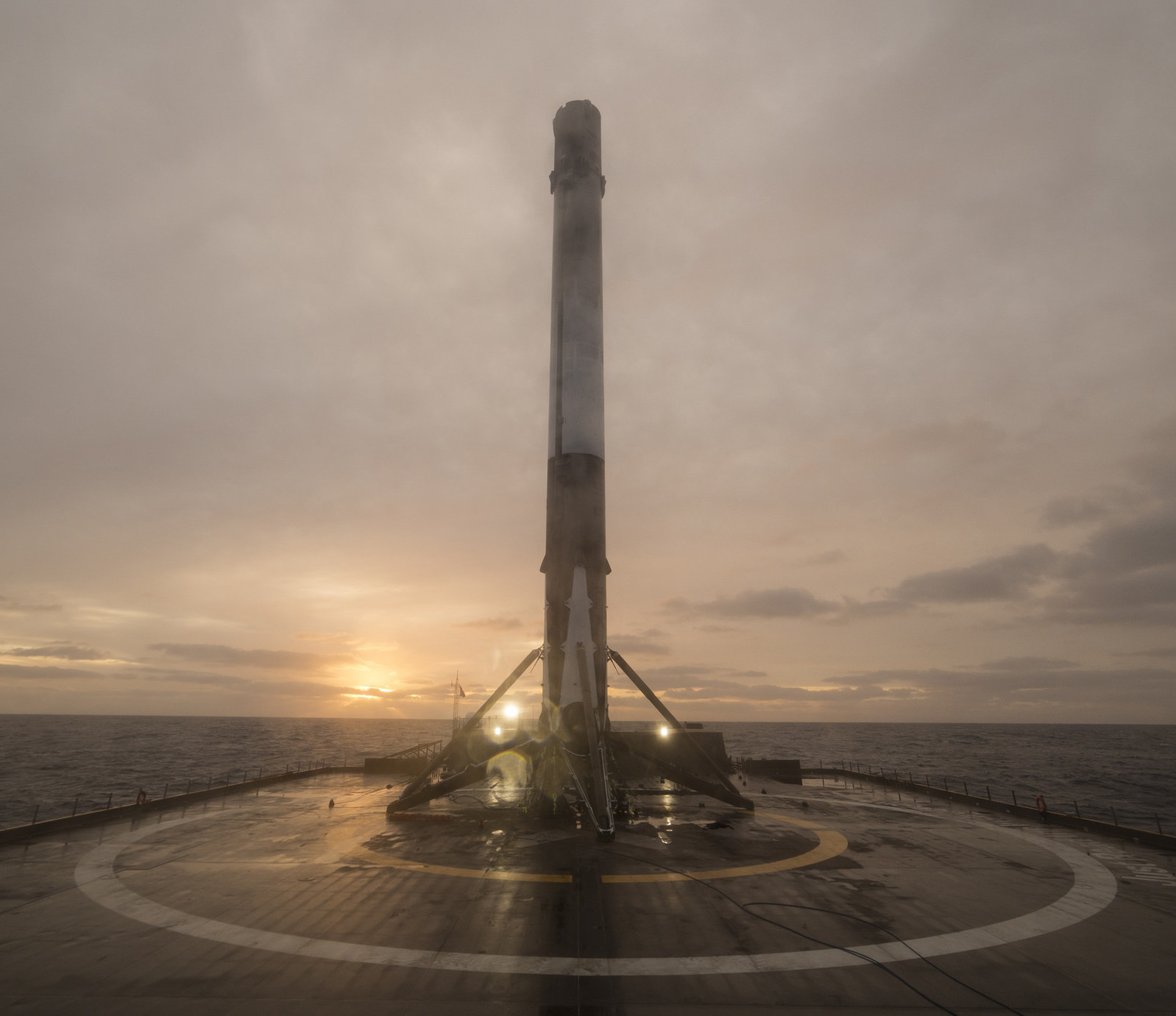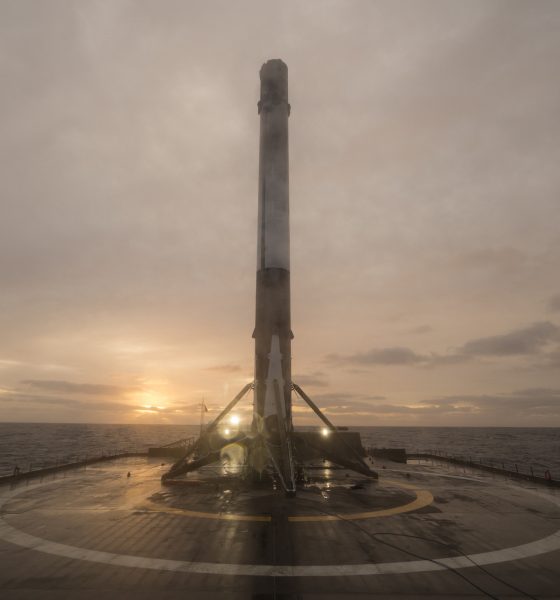

News
How SpaceX is able to achieve its amazing rocket landing accuracy
After SpaceX’s successful and uniquely exciting launch of Taiwan’s Formosat-5 remote sensing satellite, Elon Musk took to Twitter to reveal some fascinating details about the launch and recovery of the Falcon 9 first stage.
Unabashedly technical, the details Musk revealed demonstrate the truly incredible accuracy of Falcon 9’s recovery, honed over 20 landing attempts and numerous modifications to the launch vehicle. The accuracy is best understood within the context of Falcon 9’s scale and the general scope of orbital rocketry.
Touchdown:
Vertical Velocity (m/s): -1.47
Lateral Velocity (m/s): -0.15
Tilt (deg): 0.40
Lateral position: 0.7m from target center— Elon Musk (@elonmusk) August 25, 2017
The first stage of Falcon 9 Full Thrust, currently the active version of Falcon 9, stands 140 feet tall and 12 feet in diameter. If you can, for a moment, picture a 737 airliner, the plane most people have likely flown aboard on domestic flights. The first stage of Falcon 9 is the same length or greater and the same diameter as Boeing’s workhorse airliner. If you are now imagining a 737 landing on its tail aboard an ocean-going barge, that is a great start. The most common version of the 737, the -800, has an empty weight of 91,000 lb, while Falcon 9’s empty first stage is a bit more than half as heavy. With a full load of fuel, Falcon 9 S1 (first stage) weighs nearly three times as much as the 737-800. A single Merlin 1D engine out of Falcon 9’s namesake nine rocket engines has nearly ten times the thrust of the airliner. In short, Falcon 9’s first stage is massive, both extremely light and extremely heavy, and has a mind-boggling amount of thrust.
Falcon 9’s ability to land as accurately as it does is due to a combination of multiple technologies and vehicle modifications. Most visible are S1’s cold gas maneuvering thrusters and aluminum or titanium grid fins, both of which are designed to provide some level of control authority and maneuverability to the first stage during its trip within and without Earth’s atmosphere. At the peak of its trips, the first stage is often completely outside of the vast majority of the atmosphere, meaning that aerodynamic forces are no longer relevant or useful for the vehicle. This is where the cold gas thrusters come in: by carrying their reaction mass with them (the gas), Falcon 9 can maneuver outside of the atmosphere. Once the stage descends into thicker atmospheric conditions, the grid fins deploy and are used like wings to guide the stage down to its landing location, be that on land or at sea. While the gas thrusters lose a lot of their utility once in the atmosphere, they can still be used to add a small amount of control authority when needed. They were famously seen fighting a futile battle to save a first stage aboard OCISLY in 2015.
With this in mind, we can take a closer look at Musk’s technical details. First off, we have a photo of the landed booster, Falcon 9 1038, clearly almost dead center on the droneship Just Read The Instructions. More specifically, Musk reports that 1038 landed less than a single meter off the center of the target, and it landed with less than a single meter per second of latent velocity. The first stage thus managed both a soft and deadly accurate landing after traveling to a height of 150 miles – well into what is technically “space” – at a maximum speed of 1.5 miles per second. Without delving further into the details, this is best summarized as “insanely fast”, and is a bit faster than the X-15 rocketplane’s fastest recorded speed. To better put this into context, Falcon 9 1038 traveled to an altitude of 240,000 meters at a top speed of 2,400 meters per second, turned around, and landed on an autonomous barge about two feet off of its optimal target. It is truly difficult to describe how impressive that kind of accuracy is.

The hypersonic X-15 and Falcon 9 S1, with a 737-800 on the right. All vehicles are to scale. (Wikipedia, SpaceX)
Mr. Musk nevertheless did not let 1038 steal all the fanfare, and revealed that the first stage responsible for launching BulgariaSat-1, 1029, had the honor of being the fastest first stage yet, clocking in at at a truly staggering Mach 7.9, or 2,700 meters per second. That speedy mission marked the stage’s second flight and was SpaceX’s second successful reuse of a Falcon 9. Indicative of the intense speed and heat the core experienced, one of the vehicle’s grid fins was noted to have almost completely melted through. Aluminum’s melting point begins at 1,221°F.
- The central aluminum grid fin of 1029 features a dramatic lack of several vanes, likely melted off during the intense heat of reentry. Expending older boosters is likely helping SpaceX learn how to preserve Block 5 rockets for multiple high-energy missions. (Reddit, u/thedubya22)
- SpaceX will move to titanium grid fins in the future, first trialed during 1036’s launch of Iridium-2. (SpaceX)

News
Tesla FSD fleet is nearing 7 billion total miles, including 2.5 billion city miles
As can be seen on Tesla’s official FSD webpage, vehicles equipped with the system have now navigated over 6.99 billion miles.

Tesla’s Full Self-Driving (Supervised) fleet is closing in on almost 7 billion total miles driven, as per data posted by the company on its official FSD webpage.
These figures hint at the massive scale of data fueling Tesla’s rapid FSD improvements, which have been quite notable as of late.
FSD mileage milestones
As can be seen on Tesla’s official FSD webpage, vehicles equipped with the system have now navigated over 6.99 billion miles. Tesla owner and avid FSD tester Whole Mars Catalog also shared a screenshot indicating that from the nearly 7 billion miles traveled by the FSD fleet, more than 2.5 billion miles were driven inside cities.
City miles are particularly valuable for complex urban scenarios like unprotected turns, pedestrian interactions, and traffic lights. This is also the difference-maker for FSD, as only complex solutions, such as Waymo’s self-driving taxis, operate similarly on inner-city streets. And even then, incidents such as the San Francisco blackouts have proven challenging for sensor-rich vehicles like Waymos.
Tesla’s data edge
Tesla has a number of advantages in the autonomous vehicle sector, one of which is the size of its fleet and the number of vehicles training FSD on real-world roads. Tesla’s nearly 7 billion FSD miles then allow the company to roll out updates that make its vehicles behave like they are being driven by experienced drivers, even if they are operating on their own.
So notable are Tesla’s improvements to FSD that NVIDIA Director of Robotics Jim Fan, after experiencing FSD v14, noted that the system is the first AI that passes what he described as a “Physical Turing Test.”
“Despite knowing exactly how robot learning works, I still find it magical watching the steering wheel turn by itself. First it feels surreal, next it becomes routine. Then, like the smartphone, taking it away actively hurts. This is how humanity gets rewired and glued to god-like technologies,” Fan wrote in a post on X.
News
Tesla starts showing how FSD will change lives in Europe
Local officials tested the system on narrow country roads and were impressed by FSD’s smooth, human-like driving, with some calling the service a game-changer for everyday life in areas that are far from urban centers.

Tesla has launched Europe’s first public shuttle service using Full Self-Driving (Supervised) in the rural Eifelkreis Bitburg-Prüm region of Germany, demonstrating how the technology can restore independence and mobility for people who struggle with limited transport options.
Local officials tested the system on narrow country roads and were impressed by FSD’s smooth, human-like driving, with some calling the service a game-changer for everyday life in areas that are far from urban centers.
Officials see real impact on rural residents
Arzfeld Mayor Johannes Kuhl and District Administrator Andreas Kruppert personally tested the Tesla shuttle service. This allowed them to see just how well FSD navigated winding lanes and rural roads confidently. Kruppert said, “Autonomous driving sounds like science fiction to many, but we simply see here that it works totally well in rural regions too.” Kuhl, for his part, also noted that FSD “feels like a very experienced driver.”
The pilot complements the area’s “Citizen Bus” program, which provides on-demand rides for elderly residents who can no longer drive themselves. Tesla Europe shared a video of a demonstration of the service, highlighting how FSD gives people their freedom back, even in places where public transport is not as prevalent.
What the Ministry for Economic Affairs and Transport says
Rhineland-Palatinate’s Minister Daniela Schmitt supported the project, praising the collaboration that made this “first of its kind in Europe” possible. As per the ministry, the rural rollout for the service shows FSD’s potential beyond major cities, and it delivers tangible benefits like grocery runs, doctor visits, and social connections for isolated residents.
“Reliable and flexible mobility is especially vital in rural areas. With the launch of a shuttle service using self-driving vehicles (FSD supervised) by Tesla in the Eifelkreis Bitburg-Prüm, an innovative pilot project is now getting underway that complements local community bus services. It is the first project of its kind in Europe.
“The result is a real gain for rural mobility: greater accessibility, more flexibility and tangible benefits for everyday life. A strong signal for innovation, cooperation and future-oriented mobility beyond urban centers,” the ministry wrote in a LinkedIn post.
News
Tesla China quietly posts Robotaxi-related job listing
Tesla China is currently seeking a Low Voltage Electrical Engineer to work on circuit board design for the company’s autonomous vehicles.

Tesla has posted a new job listing in Shanghai explicitly tied to its Robotaxi program, fueling speculation that the company is preparing to launch its dedicated autonomous ride-hailing service in China.
As noted in the listing, Tesla China is currently seeking a Low Voltage Electrical Engineer to work on circuit board design for the company’s autonomous vehicles.
Robotaxi-specific role
The listing, which was shared on social media platform X by industry watcher @tslaming, suggested that Tesla China is looking to fill the role urgently. The job listing itself specifically mentions that the person hired for the role will be working on the Low Voltage Hardware team, which would design the circuit boards that would serve as the nervous system of the Robotaxi.
Key tasks for the role, as indicated in the job listing, include collaboration with PCB layout, firmware, mechanical, program management, and validation teams, among other responsibilities. The role is based in Shanghai.
China Robotaxi launch
China represents a massive potential market for robotaxis, with its dense urban centers and supportive policies in select cities. Tesla has limited permission to roll out FSD in the country, though despite this, its vehicles have been hailed as among the best in the market when it comes to autonomous features. So far, at least, it appears that China supports Tesla’s FSD and Robotaxi rollout.
This was hinted at in November, when Tesla brought the Cybercab to the 8th China International Import Expo (CIIE) in Shanghai, marking the first time that the autonomous two-seater was brought to the Asia-Pacific region. The vehicle, despite not having a release date in China, received a significant amount of interest among the event’s attendees.










